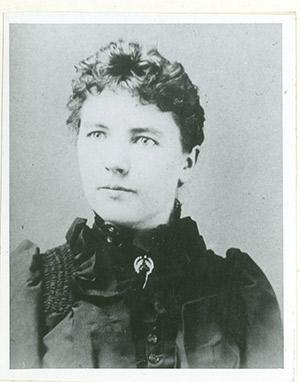In Laura Ingalls Wilder’s On the Banks of Plum Creek, Pa heads to town promising to return by nightfall, but a terrible storm blows through, and he finds himself trapped in a snow bank for three days. To survive, he eats the candy he brought for the girls’ Christmas stockings.
It’s a tale of pluck and miscalculation not lost on the publishers of Pioneer Girl, Wilder’s new annotated autobiography. Last November, they found themselves trapped in a snowbank of preorders for the book, which they won’t dig their way out of until March. They didn’t have to eat the Christmas peppermints, but they did leave Wilder fans crying in their homespun handkerchiefs when the book didn’t arrive in time for the holidays.
“Everyone keeps saying, ‘Where’s my copy, where’s my copy?’ ” says Sandra Hume, writer for the Beyond Little House blog and co-founder of the biennial “LauraPalooza,” a festival of all things Ingalls (which in previous years featured comedy of the Nellie Oleson actress from the TV series and a presentation by a meteorologist on the historical validity of Wilder’s The Long Winter).
Nancy Tystad Koupal, director of the South Dakota State Historical Society Press, the book’s publisher, said that Pioneer’s initial print run was 15,000. The books arrived at their warehouse the first week in November. By Thanksgiving, the press had not only exhausted that supply, but would take some 15,000 more orders. Coverage in a raft of publications, from The L.A. Times to the National Enquirer, sent demand through the sodhouse roof.* And that didn’t even count Amazon’s orders, which were around 30,000 and didn’t arrive until December. Those are the ones that won’t be filled until the third print run in March-ish.
Wilder wrote Pioneer, the edgier, grown-up version of her Little House series, before she wrote the children’s books. When it turned out to be unsellable to publishers, Wilder’s daughter, Rose Wilder Lane, suggested they rethink it. Some of the real-life rough stuff was either softened or taken out entirely for a younger audience. For instance, in an especially poignant and beautifully written passage in By the Shores of Silver Lake, the family’s beloved old brindle bulldog, Jack, dies peacefully in the grasses before the family pulls up stakes for South Dakota. In Pioneer Girl, the family much less elegiacally trades Jack and some ponies for a team of horses to take them back to the Upper Midwest.
After Lane’s death, the manuscript of Pioneer Girl was primarily relegated to the Herbert Hoover Presidential Library (or bootleg copies that you could get if you knew the right people) as attempts to publish it fizzled out or fell through. Commercial publishers apparently didn’t see enough potential to take on the project. But around 2009, representatives from the South Dakota press began talking with Wilder scholar Pamela Smith Hill, author of a well-received book about Ingalls called A Writer’s Life, about publishing an annotated version of the book.* Then came fundraising for the research, from foundations and private donors.
The size of the initial print run might seem ridiculously small, considering that Wilder’s Little House books have sold more than 60 million copies. “But you have to understand—this is an academic book,” says Koupal. Pre-Pioneer Girl, the press’s best-seller was the children’s book Tatanka and the Lakota People: A Creation Story, which sold around 15,000 copies.*
“We felt we were taking a huge risk even to do [15,000].”
Hume herself doesn’t have a copy of Pioneer Girl yet. “I kind of thought I’d get it for Christmas, but I didn’t,” she says. “I should have hinted to my husband more.” “Used” copies on Amazon (in this case meaning “existing”) started at $399 as of this writing, but Hume’s friend in Washington state turned up one miraculously unclaimed in a local bookstore and is sending it to her.
Other fans may have to settle for a cup of hot chocolate and a well-worn copy of The Long Winter until the weather breaks.
Hume says she can’t remember the last time there was a run on a Laura Ingalls Wilder–themed book. But the Little House book and TV series’ international appeal, plus Pioneer Girl’s “real-life grittiness” was just the thing to bring latent Wilder fans out of the woodwork.
“There’s a pretty finite number of people who are really interested in Laura Ingalls Wilder’s real life,” she says. “But then you put up a Huffington Post story on something about Little House, and it gets a zillion hits. It was big news about a year ago that a doctor did a study on what caused Mary Ingalls’ blindness.”
Last week, Hill, who wrote the book’s lively historical annotations on the minutiae of Ingalls family life, urged fans to be patient. “Members of my own family didn’t order copies in time,” she commiserated on her blog. Meanwhile, acolytes in the pioneergirl Facebook group speculated*: “Is there any chance that the print run size was all a clever ploy to sell more books? Something so hard to get must be amazing, right?”
*Correction, Jan. 20, 2015: This post originally misidentified the book section of the L.A. Times
as the LA Times Review of Books. It also stated that Pamela Smith Hill started to talk to South Dakota press in 2005, when talks began in 2009. It misidentified the press’s best-seller prior to Pioneer Girl, which was Tatanka and the Lakota People: A Creation Story, not Taksuna: A Dakota Horse Legend. It also misidentified pioneergirl, the Facebook group that speculated about the print run.
